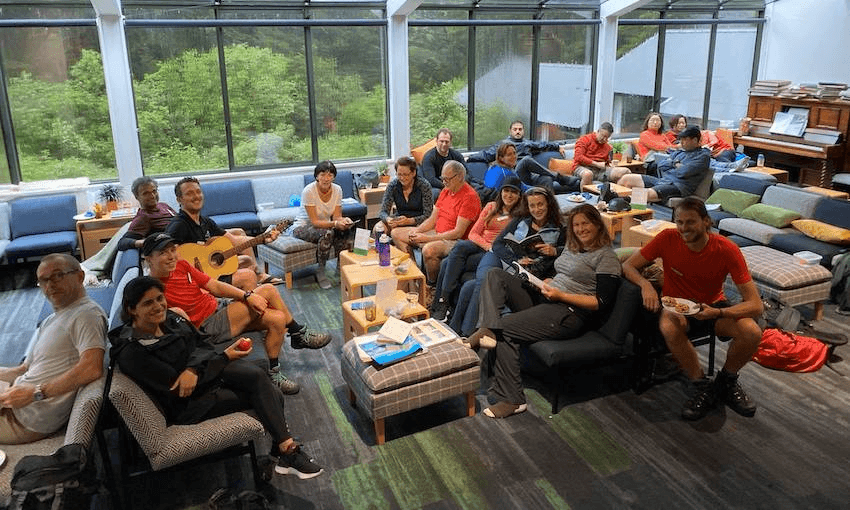For three nights, four guides and 41 trampers were stuck on the Milford Track as more than a metre of rain fell in 48 hours. Guide Oliver Missen was witness to the downpour.
The trip started as usual. We met in Queenstown, looked through the weather update, then quickly repacked to make sure my rain jacket was near the top. We were looking at 300mm of rain over a 24 hour period.
On the Milford Track, we’re well accustomed to rain, parts of Fiordland can get up to eight metres of it each year. But we’re even better at putting a positive spin on it for our clients. “You don’t get all these waterfalls when it’s sunny!” is a common, and true, line we use on wet mornings. However, the last week has left even the most experienced guides without words to explain what happened.
We arrived at Glade Wharf, the start of the four day, 53.5km Milford Track, to find 80 independent walkers looking sad and defeated as they readied themselves to boat back to Te Anau Downs. The Department of Conservation had taken the steps to clear the track, a fairly common step taken when adverse weather is expected. However, privately guided walks operate differently due to the resources we have available, so our group was able to continue despite the forecast.
The following day we headed out a little later than usual, waiting for a lull in the rain to ensure water levels dropped down. Our walk took us through thigh-high water but it was the several eels which really terrified the hell out of the clients. The joke about their potential to bite off your foot had been misinterpreted as a fact.
By 6pm we had all made it through to Pompolona Lodge. Spirits were high, and we believed the worst of the weather system had been and gone with nothing to show but wet boots and a fear of eels.
But I lay in bed that night anxious about the following day as the rain pounded on the roof heavy and continuous throughout the night. It didn’t stop. Neither did the thunder and lightning bouncing off the mountains through the valleys. The waterfalls that had trickled down the valley walls the previous day had merged into mega torrents of water. The water pounded down from the sky with a powerful force, drowning the valley floor.
The call came through from our manager in the Queenstown office at 7am: “don’t leave the lodge, there’s a hell of a lot going on right now, we’ll be in touch”. We made an announcement to the group that the journey was on hold.
We waited, and nodded with anxious smiles as most of our clients said “bloody hell, we’re glad we’re not walking in this”. We knew full well the impact this weather would be having on certain points of the track. By midday it was decided, we would stay at the hut for another night and, to be honest, we were all relieved.
We got news from Queenstown that there was a state of emergency declared and our company’s lodge in Milford sound, Mitre Peak, had been transformed into the Civil Defence Centre and hundreds of people were sleeping there. The intensity of the rain started to have context.
The plan the next day was to fly to Quintin lodge in the morning to catch up to our scheduled walking times. But again the rain didn’t stop all night. Queenstown called again letting us know they were going to evacuate the group, but the weather refused to provide a window to allow a helicopter to get to the lodge. Hang tight we were told.
Our customers understood, but it was clear cabin fever was creeping. We scratched our heads to come up with some entertainment for our guests. One of the guides, Kaz, decided to run a fruit carving workshop (who knew apples could be turned into swans in two and a half minutes flat). We also held a quiz based on an assortment of questions from a 2002 Trivial Pursuit game. There was a limited supply of reading beyond the 90s Mills and Boon novels, which had been discarded by previous hikers for a reason.
That afternoon the rain eased. A few guides set out to check the conditions of the track. Most of it had held up well, but the power of the raging water was clear. Massive boulders had moved, trees had fallen on the track and bridges were dislodged. The tail end of the track closest to Milford Sound was the most significantly damaged. Doughboy, a clearing in the track, had suffered extensive damage from slips and Giants Gate bridge was completely wiped out. We were grateful that three nights at the lodge was barely a tough price to pay. It was clear how much worse it could have been.
The following morning the 41 clients and four guides escaped the Milford Track on a 25-minute flight from Pomopolona Lodge to Glenorchy where we met the other hikers who had been evacuated. From above the valley, we were able to see the extent of the damage. Flooded rivers and landslides were clearly visible as we flew across the divide near the Routeburn. The beauty of Fiordland is built on the brutality of its natural setting. For three days we were witness to its true force.
We’re not sure when we’ll get the go ahead to get back on track, but when we do, it will be with a new appreciation for the power of New Zealand’s environment, and some more eel facts.
